Samos is located in the Eastern Aegean and is only 1 km from the Turkish mainland. The island is almost 500 square kilometers in size and has about 35,000 inhabitants (as of 2024). The capital is Vathy (less commonly called Vatheos). Samos is very mountainous. The island is dominated by Mount Kerketeus (height 1,430 m). Samos is green, water-rich and forested by Greek standards.
Great day trip by boat from Samos to Samiopoula: >>> More information and booking
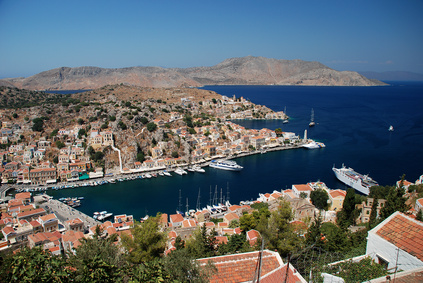 Image: marekz99 – Fotolia.com
Image: marekz99 – Fotolia.com
Samos was much more important in ancient times than it is today. It was one of the richest islands in Greece. It was also the home of the world-famous intellectuals such as the philosopher and mathematician Pythagoras. Many people will know his theories about the ratio of sides in a right-angled triangle from school (a² + b² = c²). Samos was also a wealthy island in the Roman era and especially in the Byzantine period. Then the Turks came and Samos became insignificant. After almost 100 years of fighting, Samos became Greek again in 1913.
A world-famous wine is produced on Samos, the Samos wine, which is up to 15% strong and more reminiscent of a liqueur. It is a Muscat wine (muscat wine), which is mainly grown in areas around 500 meters above sea level. It is a dessert wine, but certain wines from Samos also go well with starters and main courses. You can get a good bottle on Samos for around 10 euros. Wine growing has been a tradition on the island since ancient times. Even then, particularly sweet wines were grown.
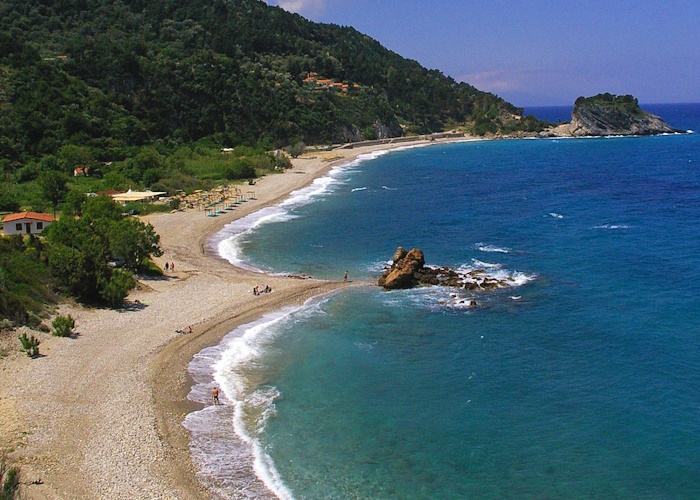
There is a good diving school on Samos called Samos Diving. Another company offers sea kayaking trips along the coast. There are also kayaking trips that last several days.
Places on Samos
Vathy
The most important port and main town on the island of Samos. Many tourists do not stay in Vathy because there are no good beaches in and around Vathy. Vathy has a beautiful promenade with taverns, cafes and shops. A must-see in Vathy is the Archaeological Museum (open daily except Mondays 8:30 a.m. to 3:30 p.m. (in summer and winter), entrance fee 2024 4 euros for adults).
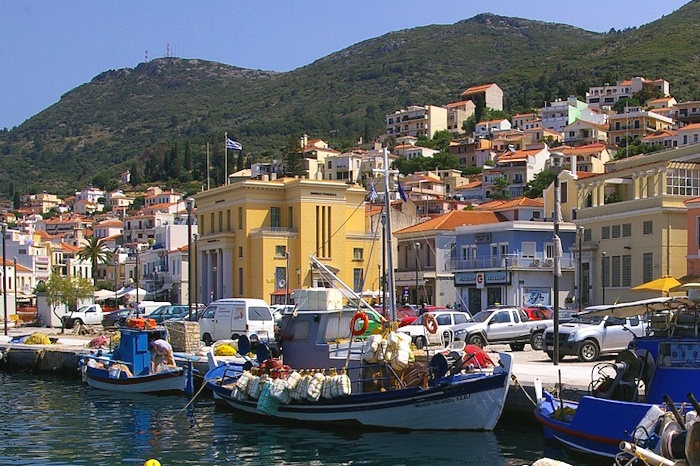
Pythagorio
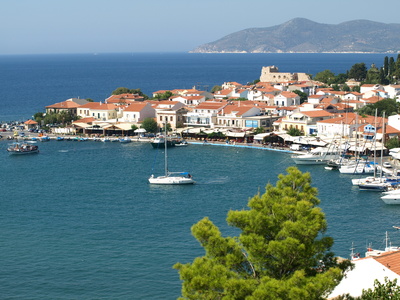 Image: Niklas Kratzsch – Fotolia.com. The most important holiday resort on the island is the small fishing village of Pythagorio with around 5,000 inhabitants.
Image: Niklas Kratzsch – Fotolia.com. The most important holiday resort on the island is the small fishing village of Pythagorio with around 5,000 inhabitants.
The most important tourist resort on the island of Samos is on the south coast. Pythagorio is a beautiful little place with a romantic harbor. In ancient times the town was the capital of Samos. The mathematician Pythagoras lived here. About 50 years ago the town was renamed Pythagorio because of the town’s world-famous son. The Evpalinos Tunnel is interesting. The tunnel, which is around one kilometer long, was dug by prisoners in ancient times. The aim was to shorten the journey into the mountains to fetch water. Pythagorio has the complete infrastructure of a package tourist resort including nightlife and much more. There has also been an interesting archaeological museum in Pythagorio for several years. About three kilometers east of Pythagorio is the Turkish mainland, only about one kilometer from the island of Samos. Quite a few illegal immigrants have entered the European Union for the first time here in recent years, some of them by swimming. Since around 2015, the number of refugees has exploded. Most of the reports in the media in Europe about the island are about the refugees. This is damaging tourism on Samos, and fewer tourists are coming than before.
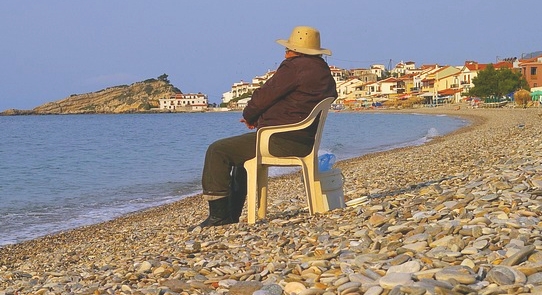
Kokkari
The second major tourist resort on Samos is Kokkari on the north coast, about 10 kilometers from the capital. Kokkari is mainly visited by package tourists. Outside of the main season, however, it is easy to find a room here. Not too far from Kokkari is a mountain village called Vourliotes, which is worth seeing. Near the port of Kokkari there is an interesting rock that the locals call Cavos. The beaches of Kokkari are not bad. One beach is right in the town, others like Lemonakia beach are a little further out.
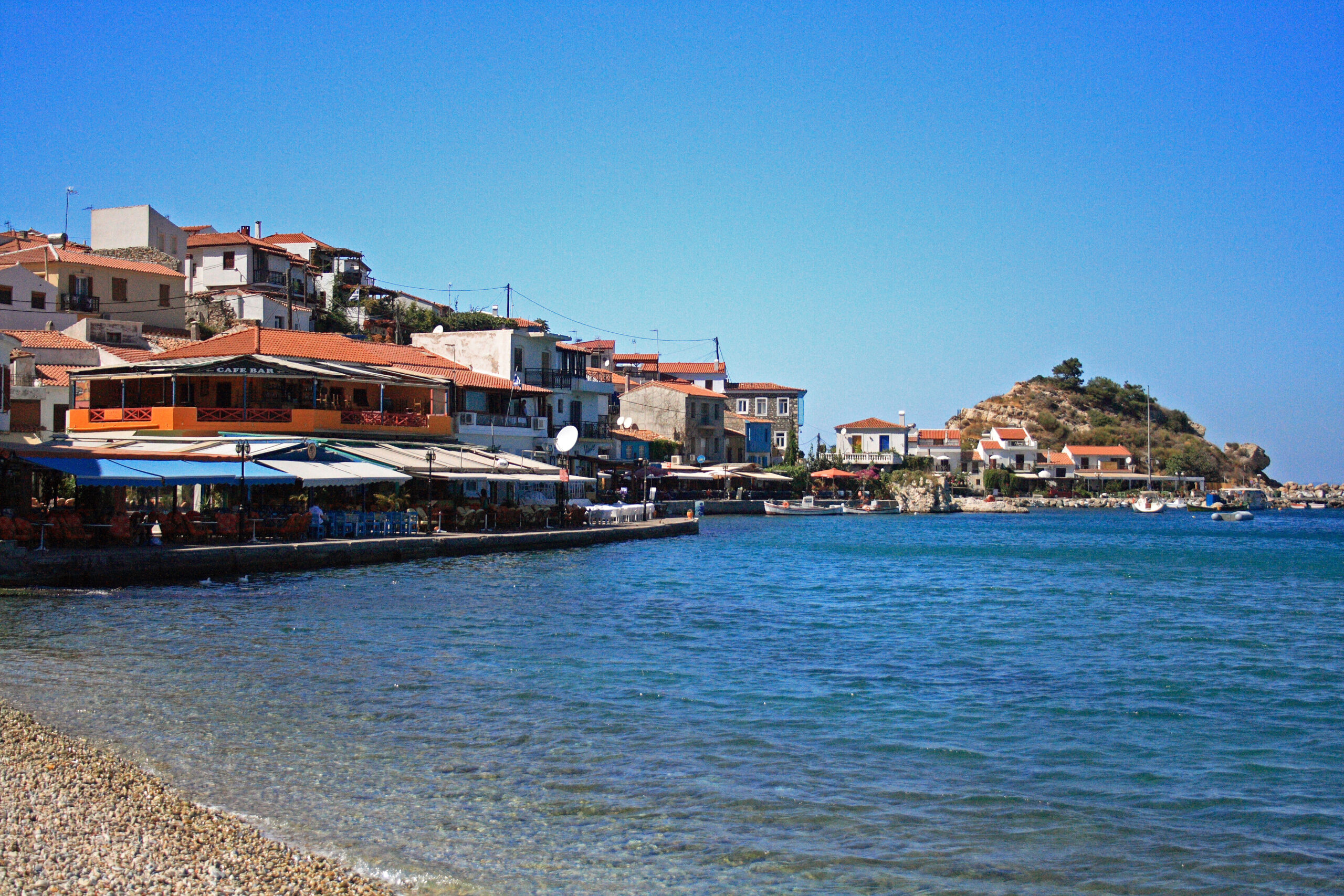
From Pe-sa – Work of the uploader, CC BY-SA 3.0, Σύνδεσμος
In Kokkari you can learn to surf at Samos Windsurfing. Of course there are also courses for advanced surfers. The company also rents out surfboards and equipment, canoes, bicycles, sea bikes and much more.
Karlovasi
The town on the north coast is the second town on Samos after Vathy. It is also the second largest ferry port on the island. The area is less touristy. There are a few newer hotels in the seaside district (Limena Karlvovasi). The small town with 7,000 inhabitants experienced a major economic boom when parts of the University of the Aegean were located in Karlovasi 30 years ago. In the small town on Samos you can study mathematics, computer science and statistics, among other things. Other parts of the university are on the islands of Rhodes, Chios and Lesbos. It is almost a must that you are offered to study mathematics on Samos, as it is the home of one of the most famous mathematicians in history, Pythagoras.
Poisonous snakes of the mountain viper species live on Samos. More information
Samos Greece: Map
The map shows the proximity to mainland Turkey. This is why, since around 2015, many refugees have been coming to Greece and the EU via the island of Samos.
The island of Fourni and the island of Ikaria are close to Samos.
Samos is a large island with a well-developed road network.
Tip: Book hotels and holiday apartments cheaper at Booking.com: Click here
Buses to Samos
There are very good bus connections on Samos during the season. Between Vathy and Pythagorio there is a bus in both directions approximately every hour. Between Vathy and Kokkari there are about 8 to 10 connections per day on the bus timetable of KTEL, the company that operates the buses on Samos. More than half of these buses continue to Karlovasi. Typically, the first buses on Samos on the main routes run around 7 a.m., the last between 7 and 8 p.m. In addition to the bus routes described above, there are many others to smaller villages and beaches. In total, there are over 30 bus routes on Samos. At weekends there are significantly fewer buses, only 2-4 per day on the main routes. Less important routes are sometimes not served at all on Saturdays and especially Sundays. In winter there are far fewer buses than stated above. The airport can also be reached from Vathy by bus for about 10 Nak daily in summer during the week.
Flights to Samos
Samos can be reached by plane directly from Germany in summer. There are direct flights to Samos from Hamburg, Munich, Berlin, Nuremberg and Frankfurt, for example. Direct flights to the island of Samos are also offered from Austria and Switzerland (from Vienna and Zurich).
As from all Greek island airports, there are flights to Athens (daily all year round). There are also connections to Thessaloniki and other islands (mainly Chios, Lesbos and Rhodes) several times a week.
The airport on Samos is in the south of the island near the town of Potokaki. There is an airport bus to the capital Vathy, which is a good 10 kilometers away. Of course, there are also taxis on Samos.
Ferries Samos
There are three ferry ports on the island of Samos: Vathy, Karlovasi and Pythagorio.
From Vathy there are ferries several times a week via Ikaria, Mykonos and Syros to Athens. Connections via Lesbos and Chios to Thessaloniki are less common. There are also many other ships on nearby islands. Smaller ferries to Kusadasi on the Turkish mainland run daily during the season.
Many of the ferries to and from Vathy stop twice on Samos. The second stop is in Karlovasi.
➔ To book ferries within Greece, we recommend the reputable website Ferryscanner.com
From Pythagorio, the ship Nisos Kalymnos sails several times a week to Leros, Patmos, Kalymnos and other islands.
In winter, there are significantly fewer ferries than described above. However, Samos can still be easily reached by ship and plane in winter.
Pythagoreion – UNESCO World Heritage Site
The Pythagoreion is one of the most impressive sights on the island of Samos. It is the remains of an ancient city that was an important cultural and economic center of the Aegean. In 1992, the Pythagoreion, together with the nearby Heraion, was recognized as a World Heritage Site by UNESCO.
Highlights of the Pythagoreion:
1.Ancient city walls
The partially preserved fortifications date from the 4th century BC and show the strategic importance of the city.
2.Roman buildings
In the Pythagoreion there are remains of Roman thermal baths and a theater, which illustrate the long history of settlement in the region.
3.Port facility
The port of the ancient city was an important hub for trade and shipping. Traces of ancient harbor walls are still visible here.
4.Tunnel of Eupalinos
The tunnel, which is also part of the Pythagoreion, is considered a masterpiece of ancient engineering and is a must-see for any visitor.
5.Museums and Artifacts
At the Archaeological Museum of Pythagoreio, visitors can marvel at numerous finds from the region, including statues, ceramics and tools.
The place today
Modern Pythagorio is a charming seaside village named after the famous mathematician Pythagoras, who was born on Samos. It is known for its picturesque alleyways, harbor with traditional taverns and relaxed atmosphere.
Why visit?
Not only a place for history lovers, the Pythagoreion is also a place that perfectly combines the fascinating mix of ancient heritage and modern joie de vivre. It is a symbol of the cultural importance of Samos in ancient times and remains an essential stop for any island visitor.
Heraion – Sanctuary of the Goddess Hera
The Heraion of Samos is one of the most important archaeological sites of ancient Greece. This sanctuary, dedicated to the goddess Hera, is located about 6 km southwest of Pythagorio and is a UNESCO World Heritage Site. It was one of the largest and most magnificent sanctuaries of antiquity and today attracts visitors from all over the world.
History of the Heraion
Mythological significance: According to Greek mythology, Hera, the wife of Zeus, was born at this very spot.
Early place of worship: Simple shrines were built here as early as the 8th century BC before the sanctuary was significantly expanded in the Archaic and Classical periods.
Archaic temple: The monumental temple was built in the 6th century BC and was one of the first large Ionic temples. It was exceptionally large, measuring 55 m long and 108 m wide.
Unique architecture: The so-called Dipteros, a temple with two rows of columns, was never fully completed, but its dimensions still impress today.
 Authorship was not indicated in a machine-readable form. It is assumed that this is an original work (based on copyright information)., CC BY-SA 3.0, Link
Authorship was not indicated in a machine-readable form. It is assumed that this is an original work (based on copyright information)., CC BY-SA 3.0, Link
Highlights of the Heraion
1.One of the largest temples in Greece
Of the 155 columns that once stood, only one remains today and is known as the site’s landmark.
2.Altis (sacred precinct)
Here were altars, smaller sanctuaries and a pond that was part of the religious ceremonies.
3.Road to the port
The remains of an ancient paved path that connected the Heraion to the ancient port are still visible.
4.Archaeological finds
Many sculptures, jewelry and cult objects from the Heraion can now be seen in the Samos Archaeological Museum in Vathy.
Why visit?
The Heraion is not only an archaeological highlight, but also a spiritual site that offers insights into the religious and cultural practices of antiquity. The size and significance of the temple show how important Hera was to the ancient Greeks, especially to the people of Samos.
A visit to the Heraion can be easily combined with a trip to Pythagorio and the Tunnel of Eupalinos.
Snakes Samos
There are several species of snakes on Samos. The poisonous snake is the Asia Minor mountain viper (Montivipera xanthina). The poison of this snake is rarely fatal to humans, but it is still dangerous. It is essential to see a doctor quickly after a bite. There are also some non-venomous snakes on Samos.
Other animals on the island of Samos
Reptiles
Turtles: Both tortoises and aquatic turtles such as the Greek tortoise and the European pond turtle are common on Samos.
Lizards and geckos: The common wall gecko and the green lizard are common.
Snakes: There are harmless species on Samos such as the ornamental snake as well as rarer species such as the sand boa.
Birds
Samos is a paradise for bird watchers, especially in the wetlands and on the coasts.
Flamingoes: These migratory birds can be seen in the salt lagoons during the winter months.
Eagles and falcons: The short-toed eagle is particularly common on the island.
Kingfisher: This colorful bird is often seen on the rivers and coasts.
Nightingales and hoopoes: Often heard in the forests and olive groves.
Mammals
Foxes and martens: These nocturnal animals are common in the forests of Samos.
Wild goats: Herds of goats can be found especially in the mountainous regions of the island.
Hedgehogs: A common but shy inhabitant of the island.
Sea creatures
The surrounding sea offers a rich variety of marine life.
Sea turtles: The loggerhead turtle (Caretta caretta) in particular can sometimes be seen off the coast.
Dolphins: Common dolphins and bottlenose dolphins can often be seen off the coast of Samos.
Fish and corals: Snorkeling and diving reveal a colorful underwater world.
Do you have any feedback, an addition, found an error or a comment? Send us an email to: mail@griechenland-insel.de